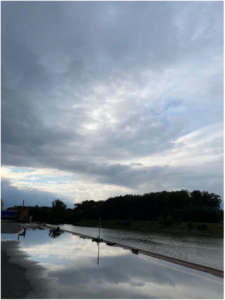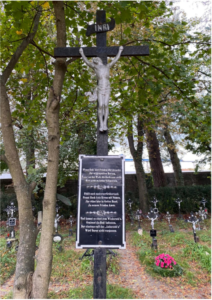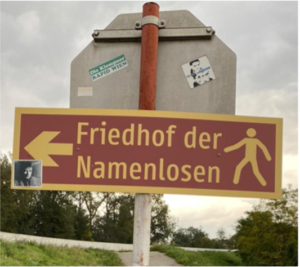Inscriptions
Tief im Schatten alter Rüstern // Starren Kreuze hier am düstern / Uferrand. / Aber keine Epitaphe, / Sage uns wer unten schlafe, / Kühl im Sand. // Still ist’s in den weiten Auen, / Selbst die Donau ihre blauen / Wogen hemmt. / Denn sie schlafen hier gemeinsam / Die, die Fluten still und einsam / Angeschwemmt. // Alle die sich hier gesellen, / Trieb Verzweiflung in der Wellen / Kalten Schoß. / Drum die Kreuze die da ragen, / Wie das Kreuz das sie getragen, / “Namenlos”.
Deep under the old elm trees’ shade // Crosses silently rise from a dark river bank, / But no epitaphs / Reveal to us who is sleeping / Cold, in the sand. // The meadows, wide, lie in silence, / Even the Danube’ blue waves / Are stalling. / For here, they all sleep together, / Those whom the floods, quietly, all deserted, / Have washed ashore. // Everyone who has gathered here / Was driven into the cold womb of the waves / By Despair. / Hence the crosses, rising here from the ground, / Similar to the crosses that they had to bear: / “Nameless”.
Description


 The so-called Alberner Hafen hosts one of Vienna’s best-hidden cemeteries: the Friedhof der Namenlosen, or cemetery of the nameless. The cemetery was in use from 1900 to 1940 (though there appear to be subsequent burials), to provide a final resting place for those who had drowned in the Danube – and its location is owed to the Danube’s currents that had repeatedly resulted in bodies of drowned individuals being washed ashore at this particular place.
The so-called Alberner Hafen hosts one of Vienna’s best-hidden cemeteries: the Friedhof der Namenlosen, or cemetery of the nameless. The cemetery was in use from 1900 to 1940 (though there appear to be subsequent burials), to provide a final resting place for those who had drowned in the Danube – and its location is owed to the Danube’s currents that had repeatedly resulted in bodies of drowned individuals being washed ashore at this particular place.
Josef Fuchs, an undertaker, chose to take care of this cemetery and to commemorate the bodies with proper burials and iron crosses for headstones, detailling what little could be established about those who had died in the cold grave that is the Danube. Upon approach, one is greeted by a legion of crucifixes, emerging from the ground: many graves merely display ‘Namenlos’ (‘nameless’) or some variation thereof, followed by e. g. the date of when the body was discovered. But there are some exceptions, and what strikes the visitor about these exceptions is that a little poetic landscape had been created. Drowning is a terrible death and the individuals who drowned, and whose bodies were snatched away by the Danube, were remembered by their relatives and friends in another, distant place, potentially without finding out about the final whereabouts of their loved ones. Memory without a place. At the same time, at Alberner Hafen a loving memory was created of those whose identity remained (mostly) unknown, by those who had no memory of the poor individuals during their lifetime. Memory without knowledge. This incredibly intense emotional conundrum, going straight to the very centre of all human fear and anxiety, about what could happen, what will happen, to us after we die and there is no-one to remember us, to provide us with a dignified burial, invites artistic reflection, it invites poetry, to give shape to, and to channel, our most profound emotions. There are numerous ancient Roman funerary epitaphs for those who died at sea. It is astonishing, as well as deeply moving, to see the similarities and differences, across cultures, across many centuries. Yet, what is apparent at Vienna’s cemetery of – and for – the nameless, more apparent than ever before, with clarity, is the way in which the extremes of our human condition and experience trigger the desire to interpret, to order, to give sense and meaning to the unfathomable, the heartbreaking, the deeply moving through poetry. And in that, places that provide us with these experiences and emotions in great density, become not only funerary (religious, …) landscapes. They also get turned into poetic ones, in which we can proceed from individual experiences to reflections on our human condition to a poetic reordering of our disturbed, disturbing universe at the point of departure. Is it not remarkable that, even though we may not know someone’s name, even though we may have died under horrendous circumstances, even though all of this may have happened far away in time and space, there are individuals out there who, out of goodness of their own hearts and their deeply held convictions and beliefs, will ensure that even the lowliest and most desperate among us, will find dignity after death? And do so even after more than a century?
Bibliography
Peter Kruschwitz, The poetics of a cemetery for the nameless, «Mappola - Mapping out the poetic landscape(s) of the Roman Empire», 2020, https://mappola.eu/index.php/2020/10/19/the-poetics-of-a-cemetery-for-the-nameless/
Peter Kruschwitz, The cold grave that is the deep, deep sea, 2014, https://thepetrifiedmuse.blog/2014/03/23/the-cold-grave-that-is-the-deep-deep-sea/
Links
Transcription author: Peter Kruschwitz
Card author: Peter Kruschwitz
Publication Date: 2021-10-28
Namenlose Friedhof
Trace type: signing up
Dating: 1900-2020
Year: 1900-1940
Language: GermanTuscan

